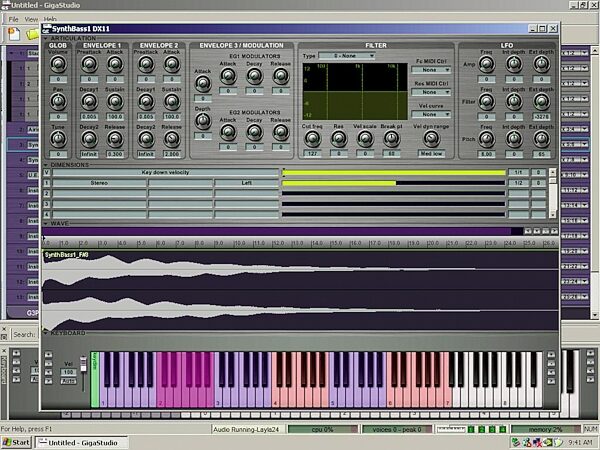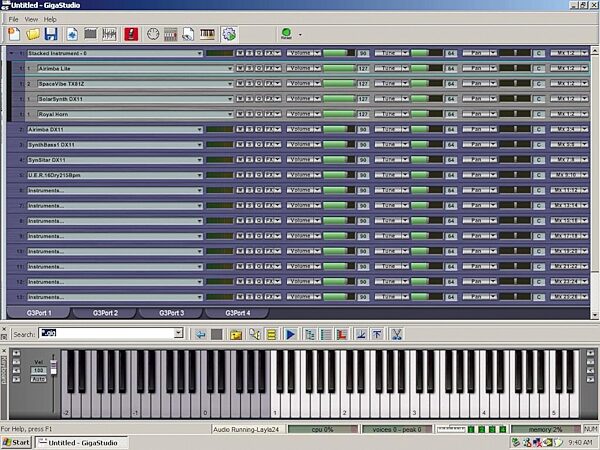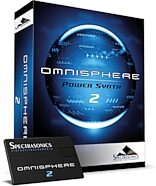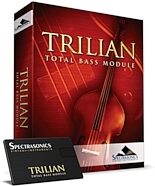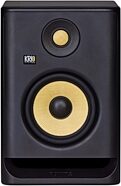TASCAM Gigastudio 3 Orchestra Sampling Software (Windows)
No longer available at zZounds




Featuring unlimited polyphony. Supports up to 512 GB of samples.
Overview
GigaStudio 3 is the much anticipated new version of the best and most powerful sampler. Available in three versions, ORCHESTRA, ENSEMBLE, and SOLO, GigaStudio 3 offers up to unlimited polyphony, 96kHz/24-bit sample support, ReWire support, VST hosting, realtime convolution modeling and a new look and feel for improved usability and workflow. Naturally, it retains the features that made GigaStudio the professional choice for sampling. As a stand-alone Windows application, GigaStudio 3 uses hard disk streaming to create the most realistic sampled instruments ever created. It offers access to the finest sound libraries ever assembled, from extensive orchestral collections, detailed piano samples, rich basses, rare keyboards and much more.
Sequencing with GigaStudio
GigaStudio 3 comes in three sizes, the Orchestra version offering unlimited polyphony for full arrangements. GigaStudio 3.0 Solo has 96-voice polyphony, and GigaStudio 3.0 Ensemble plays up to 160 voices. More voices gives you the ability to layer instruments, add parts to your arrangement and approximate huge symphonic orchestras. And the efficient kernel-level processing and RAM usage in GigaStudio results in more polyphony than any other software sampler. Up to 8 banks of 16 MIDI channels can be played back for 128-part multitimbral sequencing. Included for the first time in version 3.0 is Rewire support for routing GigaStudio into your sequencing program. This allows GigaStudio instruments to appear in your workstation… read more software, right beside plug-in instruments and audio tracks.
Streaming Samples and You
GigaStudio can load sample files up to 512 gigabytes in length. The first few milliseconds of each sample are loaded into RAM for instant playback, then the rest of the sample streams off of the hard drive. This gives you access to big, dynamic samples without needing tons of RAM into your computer.
But what does it mean to have gigabytes of samples? How is this better than the Piano sound in my favorite synth? Let's compare the 3 gigabyte GigaPiano II, included with the Orchestra and Ensemble editions of GigaStudio 3.0, with the 16 to 64 megabyte piano sample found in a typical synthesizer.
First, every key on the piano is sampled in GigaPiano II. On a typical synthesizer, the piano might only sampled twice every octave, so the middle C sample may need to stretch all the way up to middle F#. Since a piano sounds different depending on how hard you strike the key, GigaPiano II samples each key sixteen times at different velocities. A typical synth piano will only have one to three "crossswitches" per key, so you can usually hear the transition from the soft sample to the loud sample. Some piano sounds on synths don't have any crossswitches, filtering and attenuating one sample to cover the entire dynamic spectrum. More crossswitches gives you a more accurate sound, and it's also a lot more satisfying to play. GigaPiano II has enough memory to record the entire decay of a piano note, even though the low bass notes may decay for 20 seconds or more. A synthesizer can't possibly do this with just a few megabytes, so they loop the sample after only a second or so. This artificially looped sound is then attenuated using a synth filter and DCA to approximate the natural decay of a piano key, which is something GigaStudio can handle by just playing the actual recording.
Many GigaStudio libraries include different mic techniques to choose from. For example, the VintAudio Yamaha C3 library has close mic, distant mic and player's perspective mic locations. You can load all of these samples at once and balance between them when mixing, or even output different mics to multiple outputs for a 5.1 surround mix. Obviously, this is something that's impossible to do in a synthesizer.
Finally, samples are sometimes converted to a lower sampling rate to save on ROM space on synthesizers. Since they only have 50-100 megabytes of total sound ROM for all of the instruments they want to include, they might cut corners by sample rate converting to save space. For example, they may decide that a bass guitar or kick drum doesn't have a lot of high end, so re-sampling it at 22kHz is acceptable. GigaStudio is going the complete opposite direction, with version 3 now offering up to 96kHz sampling.
Hardware samplers might be able to load a bigger sample than software synthesizer, maybe up to 128MB or more, but simply nothing compares to GigaStudio. We don't mean to pick on your favorite synth, but if you haven't played a 3GB piano library you just don't know what you're missing.
Mixing in GigaStudio 3
GigaStudio 3.0 has a capable digital mixer built-in, with 128 channels and 32 fader groups. This allows you to sub-mix instruments within GigaStudio so you don't need to deal with hundreds of faders during mixdown. It includes four-band parametric EQ and compression on every channel, with a graphic display to check your settings at a glance. Each channel has 8 aux sends, which can be linked for stereo operation. GigaStudio 3 can accept up to 32 input channels, useful for processing DAW tracks through GigaPulse Pro, and can output up to 64 simultaneous output channels.
GigaStudio 3.0 now includes VST plug-in support, so you can use your favorite effects plug-ins to process sounds within the DSP Station window. Insert your favorite vintage compressor plug-in on a snare drum, a filter plug-in on a string line, tube amp distortion on a bass track - wherever your imagination takes you.
GigaStudio is a Windows application that takes advantage of the power of Pentium-compatible processors. As a free-standing application, it can take advantage of Kernel-level processing power. This means that it gets to dig underneath the Windows layer and get down to the nuts-and-bolts of your computer's CPU for more processing power. This results in more polyphony and lower latency (delay between MIDI input and sound coming out) than plug-in-based software samplers. In fact, GigaStudio has the lowest latency of any sampler, anywhere, ever.
Integration with your studio
You may be wondering how to take advantage of GigaStudio in a Mac-based studio. Most composers use a dedicated computer to run GigaStudio, dedicating all of the power of one system to running their sampling workstation. With the constantly-falling prices of PCs, you can put together a screaming system for less than the price of many rack-mount synth modules. If you look at price vs. performance, your GigaStudio computer workstation will give you much more realistic sounds than any synth module, not to mention more multitimbral parts, higher polyphony and better effects.
GigaPulse SP -- the next generation of convolution effects
GigaPulse TM is an exciting new component of GigaStudio 3. GigaPulse employs convolution to create incredibly realistic reverb, mic modeling and instrument resonance simulation. Convolution uses an actual recording as the basis for signal processing, essentially sampling the sound of a room. For example, the sound of a concert hall is recorded with a set of unique tones. This "impulse" recording can then be imported into GigaPulse Pro (the encoding processor included with GS3 Orchestra) where our concert hall impulse can be included/encoded into a sampled instrument or .gig file. When this instrument is loaded into GS3, now embedded with convolution, GigaPulse SP (the convolution player included with all version of GS3) reveals itself. Your instrument loads with the GigaPulse SP effect automatically inserted. The result sounds like you're playing in that hall.
GigaPulse Pro can also be used as a stand-alone NFX plug-in on your own sample libraries. Use the new piano resonance model included with GigaPiano II on your favorite piano library, or use GigaPulse's surround reverb on your GigaStudio instruments.
TASCAM's new GigaPulse technology takes real-time convolution to the next level. With realtime surround Acoustic Space Modeling, our proprietary technology goes far beyond any other convolution-based plug-in. The location of the performer in an acoustic space can be specifically located in the room, and the perspective of the mic can be changed for close-mic'ing simulation. Mic modeling is also included, with included impulses of the finest microphones ever made. GigaPulse has unlimited microphone locations, compared to the two channels most other convolution effects processors, which is ideal for simulating Decca-Tree mic techniques and mixing in 7.1 surround. All of these features are included in the GigaPulse SP engine in every version of GigaStudio, so that libraries encoded with GigaPulse impulses will play back in every version of GigaStudio 3.
MIDI Processing
GigaStudio 3.0 now includes a new kernel-level MIDI processing system, which means that latency is even lower than in previous versions. And since the previous version of GigaStudio had less latency than any other sampler on the market, you can imagine that sample playback in GigaStudio is just about instantaneous.
More than just changing MIDI features under the hood, GigaStudio 3.0 now offers Intelligent MIDI Processing modes. For example, the Alternation mode is great for recording string parts, where you can have notes alternate between up-bow and down-bow samples for more realism. A Legato mode triggers different samples depending how a part is played. For example, the initial attack of a flute note could have a "chiff", but legato notes played after it wouldn't have this sharp attack. And the Random mode is perfect for livening up sampled performances. Instead of triggering the same samples for repeated 16th notes, GigaStudio can select from a bank of alternate samples so the performance doesn't feel so synthetic.
Many GigaStudio libraries also include articulation files, which allow you to switch to a different instrument articulation by pressing a key. For example, pressing one key may switch to a legato viola, another key switches to an arco viola, and another to a whole-note trill. By using the keyswitches when playing a melody line, you can create very realistic lines that use three or more articulations.
Editing and recording your own sounds
GigaStudio 3.0 has a new Quick Edit window that gives you instant access to the most commonly-accessed parameters. You can still use the full editor when creating your own samples, but Quick Edit is perfect for moving a part down an octave, changing the filter setting on a bass sound, shortening the release time of a synth sound, or other common tweaks you might do when putting together an arrangement. Just close the QuickEdit window when you're finished, no need to save and reload the sound. Changes are saved with your GigaStudio performance, so the original instrument on your hard drive stays the same.
GigaStudio 3.0 now also has the ability to record samples directly into the program. Just hook your DAT machine, CD player or mic preamp to a GSIF 2-compatible sound card and start recording. GigaSampler 3.0 supports samples at 96kHz/24-bit, so you can capture instruments and effects with extreme detail. GS3 can record up to 32 simultaneous channels, so you can sample in surround or route DAW track to GigaStudio 3 for processing through GigaPulse. You can still import WAV files to put together samples from sound files on your hard disk, but now the premier sample player is now a sampler as well.
The best sound libraries in the world
It's no secret that GigaStudio has the best collection of sound libraries ever assembled. The best composers and arrangers in the music world rely on GigaStudio for accurate, musical sounds for their productions and film scores. GigaStudio's exclusive Quicksearch technology makes finding the right sound quick and easy. And with the new features in GigaStudio 3.0, those sound libraries will become even more realistic and musical.
For example, GigaPiano II is the followup to the piano that started it all. This bright, 7 foot, 4 inch Kawai piano was sampled with 24-bit resolution. Each key was recorded for its full decay at seven velocity layers with the pedal up, and another seven with the pedal down.
The true breakthrough for this library is the soundboard resonance using GigaPulse SP. The piano's soundboard was recorded and imported into GigaPulse Pro with the pedal up and down. This results in the most convincing piano sample yet released, where the performance actually interacts with the soundboard like a real grand piano. GigaPiano II is included with GS3 Orchestra and GS3 Ensemble, and a limited edition is included with GS3 Solo.
One of the most ambitious libraries of the past decade has to be Vienna Symphonic Library. The latest version of VSL, the Professional Edition, takes up 230 gigabytes for an astonishing 360,000 samples. Unique instruments and articulations include solo contrabass trombone, solo Wagner tuba, string ensembles con sordino in all articulations (staccato, detache, pizzicato, tremolo, sforzato, legato, repetitions, more), col legno, sul ponticello, flautando, Bartok (snap) pizzicatos, finger tremolos, flutter tongues for all woodwinds, a second solo flute (making up a flute quartet together with the first flute, the piccolo and the alto flute), drum ensembles and many more. And it keeps getting bigger: the new Symphonic Cube, coming soon, comes with both 24-bit and 16-bit samples.
What's New in GigaStudio 3.0
GigaStudio adds dozens of new features and enhancements to GigaStudio 2.5.
Unlimited Polyphony: Instead of a maximum 160 voices, polyphony limits for GigaStudio 3.0 Orchestra are limited only by the number of drives, drive speed, and processor speed your system has.
ReWire: GigaStudio 3.0 supports ReWire routing into sequencing/recording applications such as Cubase, Nuendo, Sonar, and Pro Tools. MIDI from the DAW is routed to GigaStudio. ReWire allows audio generated from GigaStudio to be sent into the DAW application where it automatically shows up on faders within the DAW's mixer section.
New DSP Station: The GigaStudio 3.0 mixer section has expanded to 128 channels, 32 group faders and features an expanded processing section including a 4-band EQ and compressor on each channel.
Quick Edit control: Parameters such as tuning, envelopes, filters, attenuation, and sample offset are at your fingertips in real-time without having to go into the instrument editor.
VST plug-in hosting
Real Time Surround Convolution
Intelligent MIDI: New controller rules including Expanded Legato, Alternation, Round Robin, and Random sample playback make instruments sound even more realistic.
24-Bit/96kHz instrument support: GS3 allows creation and implementation of 24-bit/96kHz sample libraries with 192K hardware support.
Enhanced Capture To Wave (multi channel): Now simultaneously record 64 audio streams.
Unlimited Instrument Stacking: Load as many instruments as you wish on a single MIDI channel. Control each of the stacked instruments parameters and even route each stacked instrument to its own audio channel.
Up to 256 Dimensions available for creating expressive keyswitches and crossfades
GSIF 2.0 with Kernel Level MIDI and support for 32 channels of audio input and 64 channels of output. Any of the DSP Station's 128 channels can be made active to support input from an outside source; our revolutionary kernel-level audio engine is now available for incoming MIDI streams.
GigaPulse SP and GigaPulse Pro: Use the breakthrough GigaPulse Pro NFX plug-in to add surround convolution reverb, instrument resonance and microphone modeling to your favorite libraries. Up to seven channels of convolution are supported for surround applications. Resonant body modeling, added to mic modeling and reverb convolution takes sampled instruments to new heights of realism and represents the next major step in sampled instruments like GigaPiano II. Sample developers now have the ability to encode their instruments using GigaPulse Pro, included with GigaStudio 3 Orchestra. These encoded instruments can be played back in any level of GigaStudio using GigaPulse SP.
Up to 512GB - 1/2 a terabyte - of samples are now supported read less
Sequencing with GigaStudio
GigaStudio 3 comes in three sizes, the Orchestra version offering unlimited polyphony for full arrangements. GigaStudio 3.0 Solo has 96-voice polyphony, and GigaStudio 3.0 Ensemble plays up to 160 voices. More voices gives you the ability to layer instruments, add parts to your arrangement and approximate huge symphonic orchestras. And the efficient kernel-level processing and RAM usage in GigaStudio results in more polyphony than any other software sampler. Up to 8 banks of 16 MIDI channels can be played back for 128-part multitimbral sequencing. Included for the first time in version 3.0 is Rewire support for routing GigaStudio into your sequencing program. This allows GigaStudio instruments to appear in your workstation… read more software, right beside plug-in instruments and audio tracks.
Streaming Samples and You
GigaStudio can load sample files up to 512 gigabytes in length. The first few milliseconds of each sample are loaded into RAM for instant playback, then the rest of the sample streams off of the hard drive. This gives you access to big, dynamic samples without needing tons of RAM into your computer.
But what does it mean to have gigabytes of samples? How is this better than the Piano sound in my favorite synth? Let's compare the 3 gigabyte GigaPiano II, included with the Orchestra and Ensemble editions of GigaStudio 3.0, with the 16 to 64 megabyte piano sample found in a typical synthesizer.
First, every key on the piano is sampled in GigaPiano II. On a typical synthesizer, the piano might only sampled twice every octave, so the middle C sample may need to stretch all the way up to middle F#. Since a piano sounds different depending on how hard you strike the key, GigaPiano II samples each key sixteen times at different velocities. A typical synth piano will only have one to three "crossswitches" per key, so you can usually hear the transition from the soft sample to the loud sample. Some piano sounds on synths don't have any crossswitches, filtering and attenuating one sample to cover the entire dynamic spectrum. More crossswitches gives you a more accurate sound, and it's also a lot more satisfying to play. GigaPiano II has enough memory to record the entire decay of a piano note, even though the low bass notes may decay for 20 seconds or more. A synthesizer can't possibly do this with just a few megabytes, so they loop the sample after only a second or so. This artificially looped sound is then attenuated using a synth filter and DCA to approximate the natural decay of a piano key, which is something GigaStudio can handle by just playing the actual recording.
Many GigaStudio libraries include different mic techniques to choose from. For example, the VintAudio Yamaha C3 library has close mic, distant mic and player's perspective mic locations. You can load all of these samples at once and balance between them when mixing, or even output different mics to multiple outputs for a 5.1 surround mix. Obviously, this is something that's impossible to do in a synthesizer.
Finally, samples are sometimes converted to a lower sampling rate to save on ROM space on synthesizers. Since they only have 50-100 megabytes of total sound ROM for all of the instruments they want to include, they might cut corners by sample rate converting to save space. For example, they may decide that a bass guitar or kick drum doesn't have a lot of high end, so re-sampling it at 22kHz is acceptable. GigaStudio is going the complete opposite direction, with version 3 now offering up to 96kHz sampling.
Hardware samplers might be able to load a bigger sample than software synthesizer, maybe up to 128MB or more, but simply nothing compares to GigaStudio. We don't mean to pick on your favorite synth, but if you haven't played a 3GB piano library you just don't know what you're missing.
Mixing in GigaStudio 3
GigaStudio 3.0 has a capable digital mixer built-in, with 128 channels and 32 fader groups. This allows you to sub-mix instruments within GigaStudio so you don't need to deal with hundreds of faders during mixdown. It includes four-band parametric EQ and compression on every channel, with a graphic display to check your settings at a glance. Each channel has 8 aux sends, which can be linked for stereo operation. GigaStudio 3 can accept up to 32 input channels, useful for processing DAW tracks through GigaPulse Pro, and can output up to 64 simultaneous output channels.
GigaStudio 3.0 now includes VST plug-in support, so you can use your favorite effects plug-ins to process sounds within the DSP Station window. Insert your favorite vintage compressor plug-in on a snare drum, a filter plug-in on a string line, tube amp distortion on a bass track - wherever your imagination takes you.
GigaStudio is a Windows application that takes advantage of the power of Pentium-compatible processors. As a free-standing application, it can take advantage of Kernel-level processing power. This means that it gets to dig underneath the Windows layer and get down to the nuts-and-bolts of your computer's CPU for more processing power. This results in more polyphony and lower latency (delay between MIDI input and sound coming out) than plug-in-based software samplers. In fact, GigaStudio has the lowest latency of any sampler, anywhere, ever.
Integration with your studio
You may be wondering how to take advantage of GigaStudio in a Mac-based studio. Most composers use a dedicated computer to run GigaStudio, dedicating all of the power of one system to running their sampling workstation. With the constantly-falling prices of PCs, you can put together a screaming system for less than the price of many rack-mount synth modules. If you look at price vs. performance, your GigaStudio computer workstation will give you much more realistic sounds than any synth module, not to mention more multitimbral parts, higher polyphony and better effects.
GigaPulse SP -- the next generation of convolution effects
GigaPulse TM is an exciting new component of GigaStudio 3. GigaPulse employs convolution to create incredibly realistic reverb, mic modeling and instrument resonance simulation. Convolution uses an actual recording as the basis for signal processing, essentially sampling the sound of a room. For example, the sound of a concert hall is recorded with a set of unique tones. This "impulse" recording can then be imported into GigaPulse Pro (the encoding processor included with GS3 Orchestra) where our concert hall impulse can be included/encoded into a sampled instrument or .gig file. When this instrument is loaded into GS3, now embedded with convolution, GigaPulse SP (the convolution player included with all version of GS3) reveals itself. Your instrument loads with the GigaPulse SP effect automatically inserted. The result sounds like you're playing in that hall.
GigaPulse Pro can also be used as a stand-alone NFX plug-in on your own sample libraries. Use the new piano resonance model included with GigaPiano II on your favorite piano library, or use GigaPulse's surround reverb on your GigaStudio instruments.
TASCAM's new GigaPulse technology takes real-time convolution to the next level. With realtime surround Acoustic Space Modeling, our proprietary technology goes far beyond any other convolution-based plug-in. The location of the performer in an acoustic space can be specifically located in the room, and the perspective of the mic can be changed for close-mic'ing simulation. Mic modeling is also included, with included impulses of the finest microphones ever made. GigaPulse has unlimited microphone locations, compared to the two channels most other convolution effects processors, which is ideal for simulating Decca-Tree mic techniques and mixing in 7.1 surround. All of these features are included in the GigaPulse SP engine in every version of GigaStudio, so that libraries encoded with GigaPulse impulses will play back in every version of GigaStudio 3.
MIDI Processing
GigaStudio 3.0 now includes a new kernel-level MIDI processing system, which means that latency is even lower than in previous versions. And since the previous version of GigaStudio had less latency than any other sampler on the market, you can imagine that sample playback in GigaStudio is just about instantaneous.
More than just changing MIDI features under the hood, GigaStudio 3.0 now offers Intelligent MIDI Processing modes. For example, the Alternation mode is great for recording string parts, where you can have notes alternate between up-bow and down-bow samples for more realism. A Legato mode triggers different samples depending how a part is played. For example, the initial attack of a flute note could have a "chiff", but legato notes played after it wouldn't have this sharp attack. And the Random mode is perfect for livening up sampled performances. Instead of triggering the same samples for repeated 16th notes, GigaStudio can select from a bank of alternate samples so the performance doesn't feel so synthetic.
Many GigaStudio libraries also include articulation files, which allow you to switch to a different instrument articulation by pressing a key. For example, pressing one key may switch to a legato viola, another key switches to an arco viola, and another to a whole-note trill. By using the keyswitches when playing a melody line, you can create very realistic lines that use three or more articulations.
Editing and recording your own sounds
GigaStudio 3.0 has a new Quick Edit window that gives you instant access to the most commonly-accessed parameters. You can still use the full editor when creating your own samples, but Quick Edit is perfect for moving a part down an octave, changing the filter setting on a bass sound, shortening the release time of a synth sound, or other common tweaks you might do when putting together an arrangement. Just close the QuickEdit window when you're finished, no need to save and reload the sound. Changes are saved with your GigaStudio performance, so the original instrument on your hard drive stays the same.
GigaStudio 3.0 now also has the ability to record samples directly into the program. Just hook your DAT machine, CD player or mic preamp to a GSIF 2-compatible sound card and start recording. GigaSampler 3.0 supports samples at 96kHz/24-bit, so you can capture instruments and effects with extreme detail. GS3 can record up to 32 simultaneous channels, so you can sample in surround or route DAW track to GigaStudio 3 for processing through GigaPulse. You can still import WAV files to put together samples from sound files on your hard disk, but now the premier sample player is now a sampler as well.
The best sound libraries in the world
It's no secret that GigaStudio has the best collection of sound libraries ever assembled. The best composers and arrangers in the music world rely on GigaStudio for accurate, musical sounds for their productions and film scores. GigaStudio's exclusive Quicksearch technology makes finding the right sound quick and easy. And with the new features in GigaStudio 3.0, those sound libraries will become even more realistic and musical.
For example, GigaPiano II is the followup to the piano that started it all. This bright, 7 foot, 4 inch Kawai piano was sampled with 24-bit resolution. Each key was recorded for its full decay at seven velocity layers with the pedal up, and another seven with the pedal down.
The true breakthrough for this library is the soundboard resonance using GigaPulse SP. The piano's soundboard was recorded and imported into GigaPulse Pro with the pedal up and down. This results in the most convincing piano sample yet released, where the performance actually interacts with the soundboard like a real grand piano. GigaPiano II is included with GS3 Orchestra and GS3 Ensemble, and a limited edition is included with GS3 Solo.
One of the most ambitious libraries of the past decade has to be Vienna Symphonic Library. The latest version of VSL, the Professional Edition, takes up 230 gigabytes for an astonishing 360,000 samples. Unique instruments and articulations include solo contrabass trombone, solo Wagner tuba, string ensembles con sordino in all articulations (staccato, detache, pizzicato, tremolo, sforzato, legato, repetitions, more), col legno, sul ponticello, flautando, Bartok (snap) pizzicatos, finger tremolos, flutter tongues for all woodwinds, a second solo flute (making up a flute quartet together with the first flute, the piccolo and the alto flute), drum ensembles and many more. And it keeps getting bigger: the new Symphonic Cube, coming soon, comes with both 24-bit and 16-bit samples.
What's New in GigaStudio 3.0
GigaStudio adds dozens of new features and enhancements to GigaStudio 2.5.
Unlimited Polyphony: Instead of a maximum 160 voices, polyphony limits for GigaStudio 3.0 Orchestra are limited only by the number of drives, drive speed, and processor speed your system has.
ReWire: GigaStudio 3.0 supports ReWire routing into sequencing/recording applications such as Cubase, Nuendo, Sonar, and Pro Tools. MIDI from the DAW is routed to GigaStudio. ReWire allows audio generated from GigaStudio to be sent into the DAW application where it automatically shows up on faders within the DAW's mixer section.
New DSP Station: The GigaStudio 3.0 mixer section has expanded to 128 channels, 32 group faders and features an expanded processing section including a 4-band EQ and compressor on each channel.
Quick Edit control: Parameters such as tuning, envelopes, filters, attenuation, and sample offset are at your fingertips in real-time without having to go into the instrument editor.
VST plug-in hosting
Real Time Surround Convolution
Intelligent MIDI: New controller rules including Expanded Legato, Alternation, Round Robin, and Random sample playback make instruments sound even more realistic.
24-Bit/96kHz instrument support: GS3 allows creation and implementation of 24-bit/96kHz sample libraries with 192K hardware support.
Enhanced Capture To Wave (multi channel): Now simultaneously record 64 audio streams.
Unlimited Instrument Stacking: Load as many instruments as you wish on a single MIDI channel. Control each of the stacked instruments parameters and even route each stacked instrument to its own audio channel.
Up to 256 Dimensions available for creating expressive keyswitches and crossfades
GSIF 2.0 with Kernel Level MIDI and support for 32 channels of audio input and 64 channels of output. Any of the DSP Station's 128 channels can be made active to support input from an outside source; our revolutionary kernel-level audio engine is now available for incoming MIDI streams.
GigaPulse SP and GigaPulse Pro: Use the breakthrough GigaPulse Pro NFX plug-in to add surround convolution reverb, instrument resonance and microphone modeling to your favorite libraries. Up to seven channels of convolution are supported for surround applications. Resonant body modeling, added to mic modeling and reverb convolution takes sampled instruments to new heights of realism and represents the next major step in sampled instruments like GigaPiano II. Sample developers now have the ability to encode their instruments using GigaPulse Pro, included with GigaStudio 3 Orchestra. These encoded instruments can be played back in any level of GigaStudio using GigaPulse SP.
Up to 512GB - 1/2 a terabyte - of samples are now supported read less
Specs
Recommended system requirements
This system should get you 200+ voices of polyphony under the Orchestra version and several instances of GigaPulse (your mileage may vary due to several factors):
Windows XP SP1
Pentium 4 2.8GHz processor or AMD 3200 XP processor (SSE-compatible processors required for GigaPulse)
1GB RAM
DVD-ROM drive
1024 x 768 monitor resolution
1GB application hard drive space
Dedicated sample drive with many free gigabytes or sample storage space; 7200 RPM with 8MB cache, 8.9ms seek time
MIDI interface
GSIF-compatible sound card or ReWire-compatible host application
Minimum system requirements
The performance of this system depends largely on how full your startup drive is. The best way to increase the polyphony of this system would be an additional hard drive just for your samples:
Windows XP SP1
Pentium 4 1.7GHz processor or AMD 2100 XP processor (SSE-compatible processors required for GigaPulse)
512MB RAM
DVD-ROM drive
1024 x 768 monitor resolution
100MB application hard drive space
MIDI interface
GSIF-compatible sound card or ReWire-compatible host application
This system should get you 200+ voices of polyphony under the Orchestra version and several instances of GigaPulse (your mileage may vary due to several factors):
Windows XP SP1
Pentium 4 2.8GHz processor or AMD 3200 XP processor (SSE-compatible processors required for GigaPulse)
1GB RAM
DVD-ROM drive
1024 x 768 monitor resolution
1GB application hard drive space
Dedicated sample drive with many free gigabytes or sample storage space; 7200 RPM with 8MB cache, 8.9ms seek time
MIDI interface
GSIF-compatible sound card or ReWire-compatible host application
Minimum system requirements
The performance of this system depends largely on how full your startup drive is. The best way to increase the polyphony of this system would be an additional hard drive just for your samples:
Windows XP SP1
Pentium 4 1.7GHz processor or AMD 2100 XP processor (SSE-compatible processors required for GigaPulse)
512MB RAM
DVD-ROM drive
1024 x 768 monitor resolution
100MB application hard drive space
MIDI interface
GSIF-compatible sound card or ReWire-compatible host application
Documents and Manuals
For support or warranty questions, please contact the manufacturer:
Phone: 323-726-0303
Web: https://tascam.com/us/support/contact
Phone: 323-726-0303
Web: https://tascam.com/us/support/contact
Reviews
Reviewers gave this product an overall rating of 0.5 out of 5 stars.
(36 ratings)
Submitted December 9, 2007 by a customer from earthlink.net
"Tascam is the worst in customer service..."
I have already replaced Gigastudio 3 Orch with a new keyboard from a another company. The reason why I'm not mentioning the other company is because I want you to know that I'm not one of their competitors. I am fine musician who's gotten financially burned by a poorly managed company. I am trying to warn other people about this problem.
Sound
The quality is only average. I've played several different systems and found better.
Value
I was never able to set-up the software and use it even though I was following Tascam's highest recomendations with regard to support gear. So would say that this software is pretty much useless to me. VALUE = 0
Manufacturer Support
I purchased Gigastudio 3 Orchestra 11 months ago in the hopes of updating the sounds for my synth. I was intending to use a laptop so that I could travel and gig with the gigastudio. Well... after many, many failed attempts to get gigastudio to run correctly with my chosen components (Tascam FW1804) I needed to call Tascam for help. Unfortunately, they were not taking calls that morning (this was during normal business hours) and they simply hung-up on my call after I had been waiting on hold for 15 minutes. In addition their support personel were NEVER able to help me set-up my system even though I was using every system that they specified on their website (no lie). Long story short... This was not the first incident of being… read more hung-up on and being misguided by their customer service, but it's definately the last for me. I bought a new keyboard instead. It was much easier to set-up, and the customer support was great. If you are reading this can can rest assured that I am an average consumer and not one of their competitors because I have never mentioned any of their other competitors in this review. Tascam's customer service is poorly managed and it shows. You'll be happier with a different product.
The Wow Factor
Well, their advertising had pulled in and I had bought the system under the assumption that this would work for me on a laptop computer. Well, $2000 into this system I decided that I was finished trying to make it work.
Musical Background:
Active musician
Musical Style:
Rock, Jazz, Blues read less
Sound
The quality is only average. I've played several different systems and found better.
Value
I was never able to set-up the software and use it even though I was following Tascam's highest recomendations with regard to support gear. So would say that this software is pretty much useless to me. VALUE = 0
Manufacturer Support
I purchased Gigastudio 3 Orchestra 11 months ago in the hopes of updating the sounds for my synth. I was intending to use a laptop so that I could travel and gig with the gigastudio. Well... after many, many failed attempts to get gigastudio to run correctly with my chosen components (Tascam FW1804) I needed to call Tascam for help. Unfortunately, they were not taking calls that morning (this was during normal business hours) and they simply hung-up on my call after I had been waiting on hold for 15 minutes. In addition their support personel were NEVER able to help me set-up my system even though I was using every system that they specified on their website (no lie). Long story short... This was not the first incident of being… read more hung-up on and being misguided by their customer service, but it's definately the last for me. I bought a new keyboard instead. It was much easier to set-up, and the customer support was great. If you are reading this can can rest assured that I am an average consumer and not one of their competitors because I have never mentioned any of their other competitors in this review. Tascam's customer service is poorly managed and it shows. You'll be happier with a different product.
The Wow Factor
Well, their advertising had pulled in and I had bought the system under the assumption that this would work for me on a laptop computer. Well, $2000 into this system I decided that I was finished trying to make it work.
Musical Background:
Active musician
Musical Style:
Rock, Jazz, Blues read less
13 of 16 people (81%) people found this review helpful. Did you?
Thanks for your opinion!
No longer available at zZounds
In most cases, a product is unavailable because it has been discontinued by the manufacturer
This is a carousel with product cards. Use the previous and next buttons to navigate.


